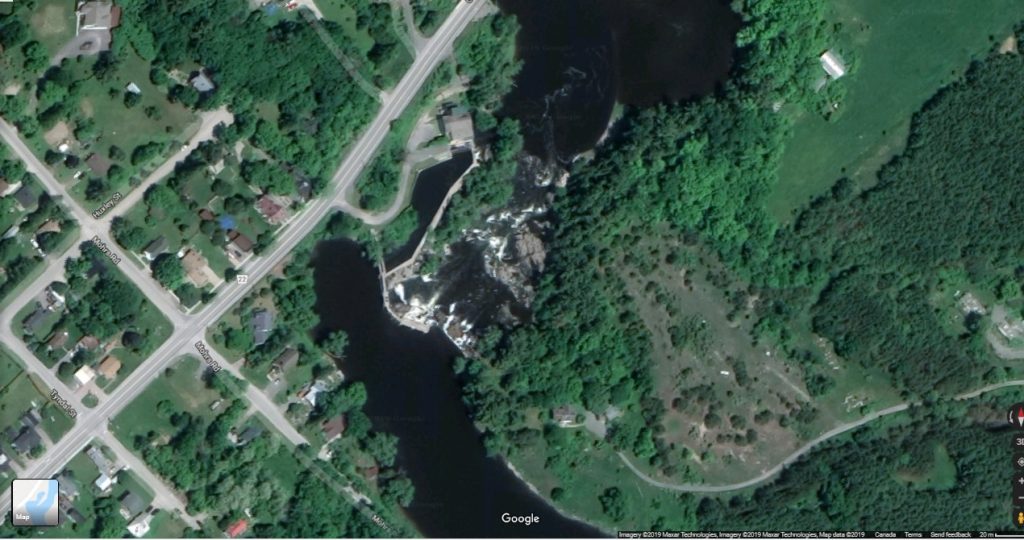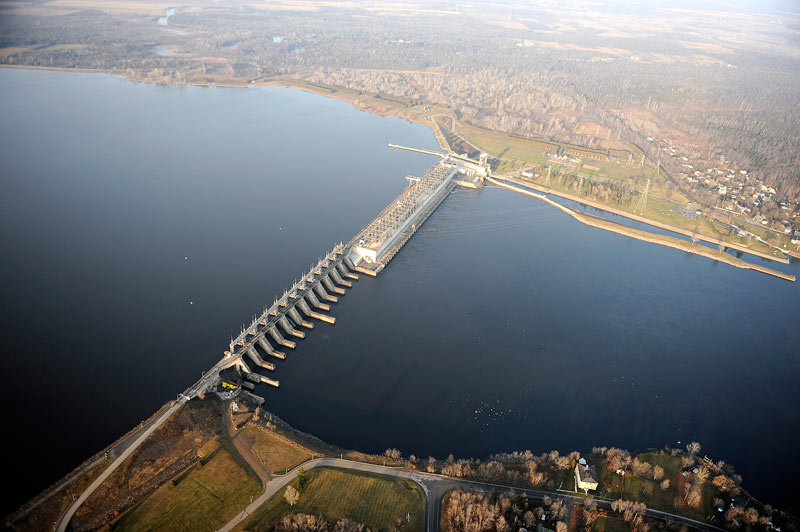Flood waters gone, questions remain
CONSTANCE BAY – The spring flood waters have receded, but life has not returned to normal for those who battled, and lost, to the worst flooding in West Carleton recorded history this year (for the most comprehensive West Carleton 2019 flood coverage, click here).
For Bayview Drive resident Gerry Blyth, things just don’t add up. You can add his name to the long list of people who agreed with Ottawa River Secretariat engineer Michael Sarich when the water expert said “people don’t believe us,” at a flood meeting held in Constance Bay July 10.
Blyth was battling the flood waters tooth and nail and pump. And then his electricity was shut off. While his house is liveable, kind of, there is extensive foundation damage. He and his wife Sue want to stay in beautiful Constance Bay, but it’s going to cost them.
The most current plan is to tear down the granny suite in his back yard. Surprisingly, despite being closer to the Ottawa River, it wasn’t damaged. Once that building is torn down, he will build a basement-less foundation on that spot. Then he will lift his primary residence and move it approximately 20 feet to the new location. Sounds expensive.
He says the water only reached the bottom of the granny suite. It wasn’t the river that got his home, it was the ground water. In 2017, the water reached four feet, 10 inches in his basement. In 2019 the water reached a height of five feet, five inches in his basement. Up to this reporter’s nose, at least.
At the time Blyth had eight electric pumps going inside and two gas pumps outside.
“We were just keeping barely keeping it at bay,” Blyth told West Carleton Online from his kitchen Wednesday, Aug. 28. “And then on May 2, at 3 p.m., I heard they were shutting down the power and that was it.”
He had just returned from Prescott, an hour or so drive and the only place he could find a gas pump with an appropriate suction hose.
“The electrical authority had to physically pull the wires out, not just turn off the breakers,” Blyth said.
The authority allowed him to rig up a small energy-providing device that gave he and his wife enough power for the fridge and the television. The gas was off, so his wife bought a two-element hot plate
to cook on and it wasn’t until mid-July they got their water back. The two travelled a mile-and-a-half to their daughter’s home for showers.
Despite the drastic change to his normal schedule, Blyth has spent a lot of time researching the spring flooding. He wants to know if this will be a regular occurrence? Will flooding get worse with time? Should he throw in the towel and move or does he and his wife have a fighting chance if they move their house, to stay in their beloved community?
Blyth is an electronic engineer who has worked for military and security interests, “but I mostly write reports.”
In 1999 he was tasked with writing Threats and Vulnerabilities of the Critical Infrastructure for National Defence headquarters’ director of information technology security on behalf of Electronic Warfare Associates-Canada, Ltd.
“I figured electricity was the mother of all critical infrastructure,” Blyth said of his focus during that work.
Blyth has attended every single meeting related to spring flooding he can, from Arnprior to Constance Bay and anywhere else he could hear from those who say they couldn’t do anything about the spring flooding. But he’s not just taking the expert’s words for it, he’s doing his own research too. He’s done a lot of reading and a lot of looking. He’s found some things he doesn’t feel quite backs up what he’s hearing from the Ottawa River Regulation Planning Board (ORRPB).
Blyth remembers when Ottawa River Secretariat executive engineer Manon Lalonde said they don’t care what happens in the St. Lawrence Seaway during the Constance Bay meeting in July.
“They said they don’t care what happens in the St. Lawrence Seaway,” Blyth said. “I have documented proof that’s not true.”
Blyth says the reason the Ottawa River Secretariat cares about the St. Lawrence Seaway is obvious – it’s stated in the ORRPB foundation agreement section: establish liason at the policy and operating levels with the International St Lawrence River Board of Control;”
“This Agreement explicitly defines their mandate,” Blyth said.
Blyth references the now famous Plan 2014 in his argument. Plan 2014 is an international agreement between the two countries related to water levels and flows in the Great Lakes and St. Lawrence River. Blyth says the reason the Ottawa River Secretariat cares about the St. Lawrence Seaway has more to do with boats, than it does floods.
Blyth says the agreement raised the trigger level for releasing high water from 243 feet above sea level to 248 feet.
“They wait until the height reaches the trigger level,” Blyth said. “They don’t start releasing water early. From what I’ve read, we know it’s for the ship levels. So, the big ships can operate at ‘top economic speed.’ Where’s the concern for home owners in that? From what I’ve read, it seems to be a compromise between allowing for reasonable ship navigation and speeds, but more importantly for maximizing power production at the two very large hydro dams between Lake Ontario and Montreal. Operating the big ships at their most economic speed is also a huge money saver for the owners. ”
Blyth has been a regular visitor of marinetraffic.com since the flood. It’s a website that tracks all boat traffic. He’s been focused on the St. Lawrence Seaway.
“There’s dozens of big ships at any given time,” Blyth said. “Hundreds a day. Every ship weighing more than 300 tonnes is required to have an Automatic Identification System (AIS).”
The AIS tracks the speed and the course and often has a photo of the ship. Blyth clicks on a few for West Carleton Online. They are all travelling around 12 to 13 knots – the typical economic speed.
“Time is money,” Blyth said.
Blyth says there are hundreds of thousands of gallons of gas to be saved by ensuring the transport ships are able to maintain their top economic speed.
“That, and hydro power production, is why the St. Lawrence Seaway, under Plan 2014, now keeps Lake Ontario at flood levels, and doesn’t release water early,” Blyth said.
Blyth doesn’t like some of the terminology the secretariat uses either. He says there are two types of dams – run-of-the-river dams and reservoir dams.

A run-of-the-river dam means water can flow freely around the dam, while a reservoir dam can completely cut off the flow from one shore to the other and then uses sluice gates to control water level in the reservoir.
“The Galetta dam is a run-of-the-river dam,” Blyth said. “The Ottawa River Regulation Planning Board (ORRPB) calls the Chaudiere Falls dam and the Carillon dam run-of-the-river dams. By definition they are not. Additionally, classifying your hydro dam as run-of-river allows you to claim that it cannot be regulated in terms of water flow and level – a significant and highly deceptive classification allowing hydro dam owners to avoid regulation from the ORRPB.”

Blyth says the 1983 agreement that established the ORRPB also has some “interesting” wording in it that does not give him confidence.
“’The goal is to provide protection against flooding along the Ottawa River and its tributaries and particularly in the Montreal region,’” Blyth reads from his copy, updated in 1994. “At the same time, to maintain the interests of the various users, particularly hydroelectric energy production.’ It’s like letting the addict run the pharmacy.”
Blyth says the introduction summary in Plan 2014 which reads “and thereby augments the principle of ‘no less protection’ to downstream interests contained in the International Joint Committee’s Order of Approval for the regulation of Lake Ontario.”
“This defines their marching orders,” Blyth said. “It can be interpreted ambiguously, but I don’t. It makes no sense to control the Ottawa River independently of the St. Lawrence Seaway.”
It is these points and others that has a community and Coun. Eli El-Chantiry demanding an independent inquiry. Minister of Natural Resources and Forestry MPP John Yakabuski said he was currying support among the three levels of government for an independent inquiry last July. He sent letters to several stakeholders at all three levels of government.
Minister of Environment and Climate Change MP Catherin McKenna replied early in August with a vague response about working together “to explore options on a potential path forward, including the scope of any proposed independent review,” but there has been little public comment since.
Blyth says he isn’t holding his breath on one coming any time soon.
““The City of Ottawa owns several dams – at least six on the Ottawa, one on the Nation River at Cassleman and four more in New York State,” he said. “Is there a conflict there? I say there is. They even state that they ‘make additional money when the water is running fast,’ and the City of Ottawa is the sole shareholder.”
“The province is also a major energy producer,” he said. “So who’s providing the oversight?”
He has a 2017 report that shows the province made $17.5 million in 2016. In 2017, a year which also had extreme flooding in West Carleton, the province made $22.9 million – a 30 per cent increase.
“Rushing waters contribute to their revenues,” Blyth said. “Who’s providing the oversight?”
But that’s where Blyth has trouble finding answers.
“The ORRPB has not been completely honest, and they have not been totally forthcoming.” he said. “In accordance with the 1983 agreement they have established a regulating committee, and this committee is to be composed of – guess who? The owners of the Ottawa River hydro dams and their reservoirs, Hydro Quebec, Ontario Power Generation and, I wonder, Energy Ottawa Inc. A perfect example of conflict of interest.”



